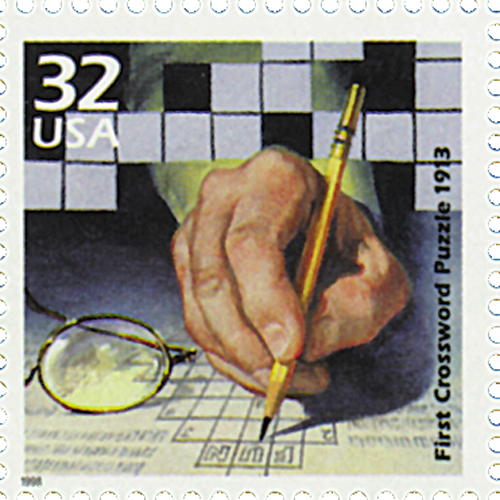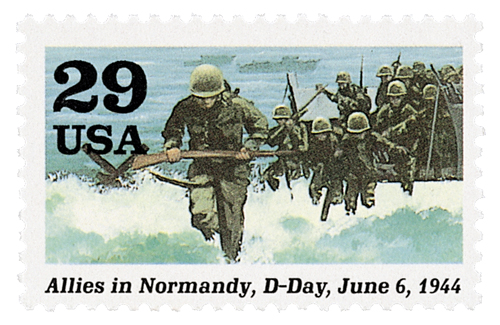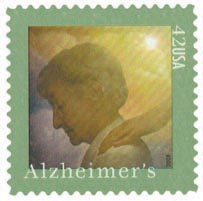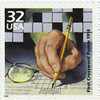
# 3183l - 1998 32c Celebrate the Century - 1910s: First Crossword Puzzle
32¢ First Crossword Puzzle Published
Celebrate the Century – 1910s
City: Washington, DC
Quantity: 12,533,000
Printed By: Ashton-Potter (USA) Ltd
Printing Method: Lithographed
Perforations: 11.5
Color: Multicolored
The First Crossword Puzzle

On December 21, 1913, the first modern crossword puzzle was published in the New York World. It began a popular hobby that is still enjoyed around the world over 100 years later.
Word puzzles were popular in the 1800s. “Cross word puzzle” was first used in the US in the 1862 magazine, Our Young Folks. There were also Double Diamond Puzzles in St. Nicholas magazine as early as 1873. In Italy, a word puzzle was published in the magazine Il Secolo Illustrato della Domenica and titled “To pass the time.” Early British crossword puzzles in children’s magazines used a word square in which words were arranged so they read the same way vertically and horizontally.

The first crossword puzzle as we know it today, was create by journalist Arthur Wynne for the New York World. First published on Sunday, December 21, 1913, he titled it “FUN’s Word-Cross Puzzle.” The puzzle was arranged in a diamond shape with the instructions “Fill in the small squares with words which agree with the following definitions.”
At one point, an illustrator reverse the words and it became known as a “cross-word.” Wynne’s puzzle proved popular with readers and they became a weekly feature in the paper. Soon other papers created their own puzzles. The Pittsburgh Press introduced theirs in 1916 and the Boston Globe in 1917. Simon and Schuster published the first book of crossword puzzles in 1924 and the word “crossword” was added to the Oxford English Dictionary in 1933.

Despite their popularity, crossword puzzles also had their critics. Librarians at the New York Public Library complained that “the puzzle ‘fans’ swarm to the dictionaries and encyclopedia’s so as to drive away readers and students who need these books in their daily work, can there be any doubt of the Library’s duty to protect its legitimate readers?” The New York Times called the puzzles a “sinful waste… a primitive form of mental exercise.” For years, the Times called crossword puzzles a fad that they expected to pass. Then in 1942, they began publishing crosswords to provide readers with an enjoyable distraction from the news of World War II.

During World War II, crosswords in Britain’s The Daily Telegraph caused quite a stir. Leonard Dawe, headmaster of Strand School created these puzzles for the paper. The school was evacuated to Effingham, Surrey, next to a large Allied military camp. The camp reportedly had minimal security and the soldiers and students spoke freely. Dawe often called on his students to put words into his puzzles, for which he would later provide clues.

In 1942, a crossword included the word Dieppe a day before the Dieppe raid. After an investigation, the War Office concluded it was just a coincidence. Then in May and June 1944, the puzzle included several answers that were codewords in the D-Day invasion of Normandy. These words included Gold, Sword, Juno, Utah, and Omaha (code names for the landing beaches), Overlord (the invasion was called Operation Overlord), Mulberry (the Allies would build Mulberry harbours at Normandy), and Neptune (the codename for the D-Day landings).
MI5 then arrested Dawe and interrogated him extensively, eventually finding him innocent. He later spoke to one of his students who had a book filled with codewords and ordered him to destroy it and stressed the importance of secrecy for national security.

Over the years, crosswords have been developed in many other countries, and new kinds have been invented, such as cryptic crosswords, metapuzzles, and crossnumbers. Over the years, several records have been set. Roger Squires of the UK was crowned “The World’s Most Prolific Crossword Compiler by the Guinness Book of Records.” He’s made over 74,600 crosswords, totaling more than 2.25 million clues. He also had the record for the longest word in a published puzzle, the Welsh town of Llanfairpwllgwyngyllgogerychwyrndrobwllllantysiliogogogoch. He also holds the record for the longest published crossword at eight feet long
32¢ First Crossword Puzzle Published
Celebrate the Century – 1910s
City: Washington, DC
Quantity: 12,533,000
Printed By: Ashton-Potter (USA) Ltd
Printing Method: Lithographed
Perforations: 11.5
Color: Multicolored
The First Crossword Puzzle

On December 21, 1913, the first modern crossword puzzle was published in the New York World. It began a popular hobby that is still enjoyed around the world over 100 years later.
Word puzzles were popular in the 1800s. “Cross word puzzle” was first used in the US in the 1862 magazine, Our Young Folks. There were also Double Diamond Puzzles in St. Nicholas magazine as early as 1873. In Italy, a word puzzle was published in the magazine Il Secolo Illustrato della Domenica and titled “To pass the time.” Early British crossword puzzles in children’s magazines used a word square in which words were arranged so they read the same way vertically and horizontally.

The first crossword puzzle as we know it today, was create by journalist Arthur Wynne for the New York World. First published on Sunday, December 21, 1913, he titled it “FUN’s Word-Cross Puzzle.” The puzzle was arranged in a diamond shape with the instructions “Fill in the small squares with words which agree with the following definitions.”
At one point, an illustrator reverse the words and it became known as a “cross-word.” Wynne’s puzzle proved popular with readers and they became a weekly feature in the paper. Soon other papers created their own puzzles. The Pittsburgh Press introduced theirs in 1916 and the Boston Globe in 1917. Simon and Schuster published the first book of crossword puzzles in 1924 and the word “crossword” was added to the Oxford English Dictionary in 1933.

Despite their popularity, crossword puzzles also had their critics. Librarians at the New York Public Library complained that “the puzzle ‘fans’ swarm to the dictionaries and encyclopedia’s so as to drive away readers and students who need these books in their daily work, can there be any doubt of the Library’s duty to protect its legitimate readers?” The New York Times called the puzzles a “sinful waste… a primitive form of mental exercise.” For years, the Times called crossword puzzles a fad that they expected to pass. Then in 1942, they began publishing crosswords to provide readers with an enjoyable distraction from the news of World War II.

During World War II, crosswords in Britain’s The Daily Telegraph caused quite a stir. Leonard Dawe, headmaster of Strand School created these puzzles for the paper. The school was evacuated to Effingham, Surrey, next to a large Allied military camp. The camp reportedly had minimal security and the soldiers and students spoke freely. Dawe often called on his students to put words into his puzzles, for which he would later provide clues.

In 1942, a crossword included the word Dieppe a day before the Dieppe raid. After an investigation, the War Office concluded it was just a coincidence. Then in May and June 1944, the puzzle included several answers that were codewords in the D-Day invasion of Normandy. These words included Gold, Sword, Juno, Utah, and Omaha (code names for the landing beaches), Overlord (the invasion was called Operation Overlord), Mulberry (the Allies would build Mulberry harbours at Normandy), and Neptune (the codename for the D-Day landings).
MI5 then arrested Dawe and interrogated him extensively, eventually finding him innocent. He later spoke to one of his students who had a book filled with codewords and ordered him to destroy it and stressed the importance of secrecy for national security.

Over the years, crosswords have been developed in many other countries, and new kinds have been invented, such as cryptic crosswords, metapuzzles, and crossnumbers. Over the years, several records have been set. Roger Squires of the UK was crowned “The World’s Most Prolific Crossword Compiler by the Guinness Book of Records.” He’s made over 74,600 crosswords, totaling more than 2.25 million clues. He also had the record for the longest word in a published puzzle, the Welsh town of Llanfairpwllgwyngyllgogerychwyrndrobwllllantysiliogogogoch. He also holds the record for the longest published crossword at eight feet long










